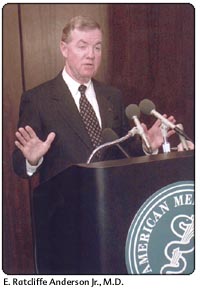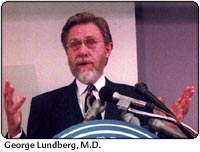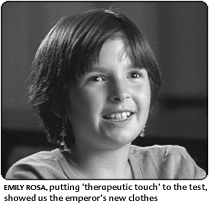tanding ramrod-straight behind the podium, the American
Medical Association's new CEO, E. Ratcliffe Anderson Jr., M.D.,  stunned a crowd of reporters
by announcing that he had fired the editor of the Journal of the American Medical
Association for publishing a study on sex.
stunned a crowd of reporters
by announcing that he had fired the editor of the Journal of the American Medical
Association for publishing a study on sex.
Editor George Lundberg, M.D., widely credited with turning a somnambulant house organ into one
of the world's top medical publications, was suddenly gone, baffling the reporters at the AMA press
conference. On Jan. 15, 1998, five days before the sex study was published, Anderson, a former
surgeon general of the United States and an Air Force and Vietnam fighter pilot, explained why he
unceremoniously jettisoned Lundberg:
for "inappropriately and inexcusably interjecting JAMA into a major political debate that
has nothing to do with science or medicine.... JAMA's hard-earned reputation is based on its
editorial independence and integrity, and we intend to keep it that way."
Lundberg provided reporters a steady flow of news stories and occasional controversies, which
sometimes rocked the boat of the AMA's conservative leaders. Nevertheless, during his 17-year
editorship, JAMA rose up to challenge the New England Journal of Medicine and
Lancet in importance while generating millions of dollars of advertising revenues.
The study1 that gave Anderson a pretext for cutting off the editorial tail
that so often wagged the dog was an analysis of data from a 1991 survey of what students at a
Midwest university thought constitutes "having sex." Nearly 60 percent of the students surveyed did
not define oral sex as having sex. Like many other timely articles, this study had been "fast-tracked"
into print. While such information could help researchers and clinicians who take medical histories,
it was of even greater interest to those involved with the impeachment of President Bill Clinton. A
main charge was that the president had perjured himself by testifying that he never had sex with
Monica Lewinsky. However, according to the study by researchers at the Kinsey Institute for Research in Sex, Gender, and
Reproduction, in Bloomington, Ind., more than half the sample population appeared to share
the president's definition.
The reaction among journalists, researchers, and academics was almost unanimous condemnation
for Anderson and the AMA. Even a former AMA board chairman expressed outrage: Raymond
 Scalettar, M.D., accused the association of firing Lundberg to appease the Republican-controlled
Congress. Although the AMA denies political partisanship, federal campaign finance reports showed
that contributions from the AMA's political action committee favored Republicans two to one
(donating $9.3 million to Republican House and Senate candidates since 1989, compared with $4.8
million to Democrats).
Scalettar, M.D., accused the association of firing Lundberg to appease the Republican-controlled
Congress. Although the AMA denies political partisanship, federal campaign finance reports showed
that contributions from the AMA's political action committee favored Republicans two to one
(donating $9.3 million to Republican House and Senate candidates since 1989, compared with $4.8
million to Democrats).
Several other recent studies also stirred the AMA's waters. On Nov. 11, 1998, JAMA
published a theme issue on
alternative medicine, which many critics said was soft on science and big on hype for unproven
remedies. The journal and Lundberg had been bashed by the other side, too: On April 1, 1998,2 JAMA published a study that tested the ability of therapeutic touch practitioners to feel an "energy field" that
surrounds people. Even more unusual than the subject matter, one of the authors was 9 years old
when she began the study as a fourth-grade science fair project.
With the advice of her coauthors (her mother, Linda Rosa, B.S.N., R.N.; Larry Sarner; and Stephen
Barrett, M.D.), Emily Rosa devised and conducted a simple test. Since she was a schoolgirl doing a
science project, she was able to do what no one else could do before or since: induce 21 therapeutic
touch practitioners to let her test their ability to sense a purported energy field. The test required the
practitioners to sit behind an opaque screen and announce which of their hands was under the child's
hand. (Which hand Emily placed hers over was determined by a coin toss.) All the practitioners
claimed they could feel her energy field, but under blinded conditions none performed better than
chance. Yet millions of dollars are charged each year by more than 40,000 therapeutic touch practitioners in the United
States, who wave their hands over patients and claim to induce healing by smoothing out
"unevenness" in their energy fields.
announce which of their hands was under the child's
hand. (Which hand Emily placed hers over was determined by a coin toss.) All the practitioners
claimed they could feel her energy field, but under blinded conditions none performed better than
chance. Yet millions of dollars are charged each year by more than 40,000 therapeutic touch practitioners in the United
States, who wave their hands over patients and claim to induce healing by smoothing out
"unevenness" in their energy fields.
The study received widespread publicity with the help of an AMA press conference. Reaction ran
from huzzahs for the child who revealed the naked emperor to charges of fraud and media
grandstanding. The study was even a subject of derision for a speaker at the "Breakthrough?"
conference, Ellen Ruppel Shell. Speaking as a mother, she said, the work of schoolchildren should be
placed on refrigerators, not in prestigious medical journals.
Steven S. Ross,
associate professor of professional practice at Columbia's Graduate School of Journalism, disagrees.
"I think the study was perfectly valid," he says, "although I think AMA's press conference and
promotions were theatrical and milked it. It wasn't a huge or sophisticated study, but it was the best
that could be done and probably the only one that will ever be done, because therapeutic touch
practitioners are not willing to test their claims. Because it is the best study ever done, you publish it.
If any critics have a problem with it, they should replicate it and try to prove the findings wrong."
While therapeutic touch proponents continue to cry foul,3 no one has come forth to repeat the study.
Ross also defends the sex study as a valid contribution to debate. "It underscored the reality that what
some people consider is 'having sex' is not considered having sex by others," he says. "The study
helped to raise doctors' awareness of this problem when taking a medical history." Kenneth
Goldstein, professor emeritus at the journalism school, agrees. "One important object for medical journals is to help doctors
understand their patients' needs and fears better," says Goldstein. "Doctors need to know
what is going on so that they're not practicing in a closet."
"Every good editor wants to be interesting, and that often requires being controversial and pushing
the envelope," Ross says. "Journal editors have to take chances. But they have to be clear about it
when they are standing on firm ground and when there may be a lot of air beneath their feet.
Mistakes will be made. But honest mistakes are legal and should not be punished."
"If they don't take chances," adds Goldstein, "they are not being editors; they are being copy editors.
They are not using their publication to the full advantage of its readers. Waiting for information to
become certain is the job of encyclopedia editors, not the editors of journals."





 stunned a crowd of reporters
by announcing that he had fired the editor of the Journal of the American Medical
Association for publishing a study on sex.
stunned a crowd of reporters
by announcing that he had fired the editor of the Journal of the American Medical
Association for publishing a study on sex. Scalettar, M.D., accused the association of firing Lundberg to appease the Republican-controlled
Congress. Although the AMA denies political partisanship, federal campaign finance reports showed
that contributions from the AMA's political action committee favored Republicans two to one
(donating $9.3 million to Republican House and Senate candidates since 1989, compared with $4.8
million to Democrats).
Scalettar, M.D., accused the association of firing Lundberg to appease the Republican-controlled
Congress. Although the AMA denies political partisanship, federal campaign finance reports showed
that contributions from the AMA's political action committee favored Republicans two to one
(donating $9.3 million to Republican House and Senate candidates since 1989, compared with $4.8
million to Democrats). announce which of their hands was under the child's
hand. (Which hand Emily placed hers over was determined by a coin toss.) All the practitioners
claimed they could feel her energy field, but under blinded conditions none performed better than
chance. Yet millions of dollars are charged each year by more than 40,000 therapeutic touch practitioners in the United
States, who wave their hands over patients and claim to induce healing by smoothing out
"unevenness" in their energy fields.
announce which of their hands was under the child's
hand. (Which hand Emily placed hers over was determined by a coin toss.) All the practitioners
claimed they could feel her energy field, but under blinded conditions none performed better than
chance. Yet millions of dollars are charged each year by more than 40,000 therapeutic touch practitioners in the United
States, who wave their hands over patients and claim to induce healing by smoothing out
"unevenness" in their energy fields.








